New Mexico, a Southwestern state of the United States, is called the Land of Enchantment because of its scenic beauty and rich history. Every year, millions of tourists go to this state for hunting, fishing, skiing, or sightseeing. New Mexico is the fifth largest state in area. Only Alaska, Texas, California, and Montana have a greater area. But the state is thinly populated. Mountain ranges, rugged canyons, and rocky deserts cover much of New Mexico.
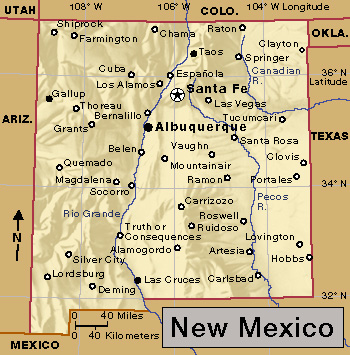
A person vacationing in New Mexico might see the state as a land of beautiful scenery, Spanish fiestas, and Indigenous (native) American ceremonies. But a scientist would think of New Mexico as a center of research into rockets and nuclear energy. An oil company executive might regard the state as a rich source of gasoline for automobiles, or of natural gas for cooking and heating. A retired couple might choose to make their home in the southern part of New Mexico because its location and high altitude provide warm, sunny days and cool nights. A rancher might be impressed by New Mexico’s vast stretches of grazing land.
Much of New Mexico’s growing industry springs from the science of the nuclear age. The first atomic bomb was built and exploded in New Mexico in 1945. Today, scientists in New Mexico search for a way to make space rockets travel on nuclear power. Other scientists develop ways to use nuclear energy for generating electric power, or work on improving nuclear weapons for defense.

New Mexico ranks among the leading states in mining. Natural gas and petroleum are New Mexico’s most important mineral products by far. Large deposits of gas and petroleum lie in both the northwestern and southeastern parts of the state. In addition, New Mexico’s resources include major deposits of coal, copper, potash, and uranium.
Cattle ranching is the most important type of farming in the state. More than a million cattle graze on the vast plains and in the mountain valleys of New Mexico.

New Mexico’s colorful past gives the state important tourist attractions. Still standing are the ruins of an apartment house with about 800 rooms built by Indigenous American people hundreds of years before Columbus arrived in America. Indigenous Americans have also been called Native Americans or American Indians. Spain ruled the land for more than 220 years. The Spanish influence may be seen today in the names of places, in the churches of early missionaries, in foods, and in customs and holidays. Colorful people such as Kit Carson, Geronimo, and Billy the Kid played major parts in the history of the New Mexico area in territorial days.
Many other historical features capture the interest of visitors to New Mexico. Within the state remain portions of the oldest road established by Europeans in the United States. This route, called El Camino Real (the Royal Highway), was first traveled about 1581. Santa Fe, the capital of New Mexico, ranks as the oldest seat of government in the United States. It was founded as the capital of a Spanish province as early as 1609 or 1610. The largest city in New Mexico is Albuquerque, which the Spaniards founded in 1706.
People
Population.
The 2020 United States census reported that New Mexico had 2,117,522 people. The 2020 population had increased 3 percent over the 2010 figure of 2,059,179. According to the 2020 census, New Mexico ranks 36th in population among the 50 states. About 65 percent of New Mexico’s people live in the state’s four metropolitan areas (see Metropolitan area). These areas are Albuquerque, Farmington, Las Cruces, and Santa Fe.
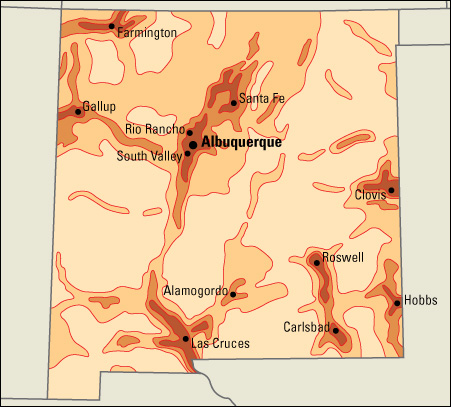
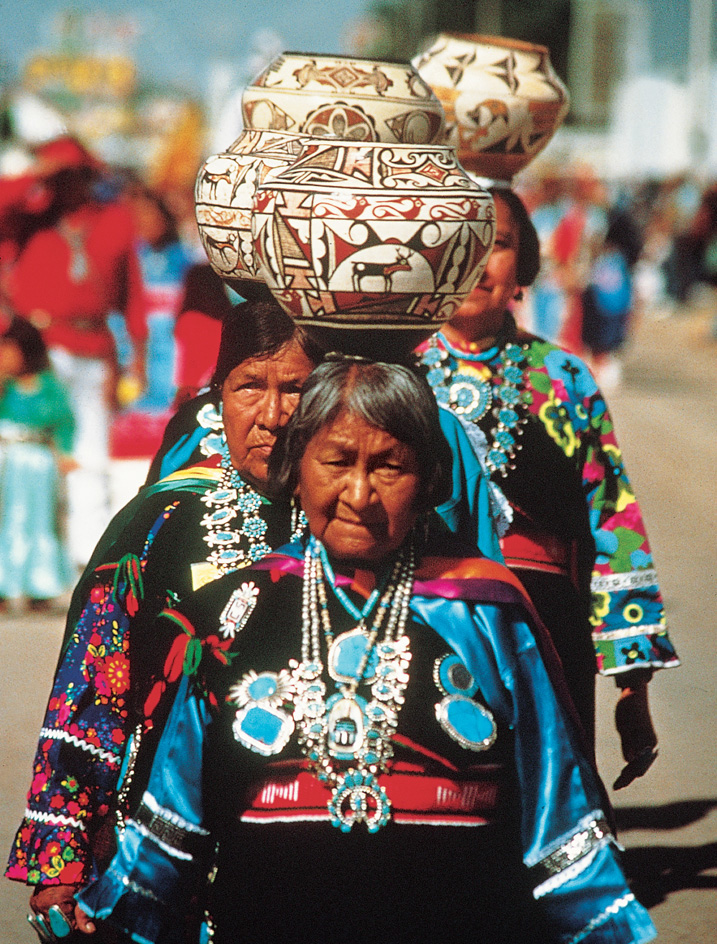
Most New Mexicans are descended from one of the three major groups that settled the area—Indigenous people, Spaniards, and English-speaking Americans. New Mexico has a higher percentage of Indigenous and Hispanic people than any other state. About half of the people are Hispanic, and about 10 percent are Indigenous American. The way of life of some Indigenous people may be much like that of their ancestors. Indigenous people might live in a pueblo (village) or on a reservation. The Spanish influence shows in place names, foods, and customs. Many New Mexicans speak both English and Spanish. Non-Hispanic white people account for about 35 percent of the population. New Mexico has small numbers of African Americans and Asians.
Schools.
In the early 1600’s, Spanish Roman Catholic priests began establishing schools in New Mexico to teach Christianity to Indigenous groups. Public education was established in the state in the late 1800’s. 
A secretary of education oversees the state’s public school districts. The secretary is appointed by the governor. The Public Education Commission, which consists of 10 elected commissioners, advises the secretary. State law requires children from ages 5 to 18 to attend school. For the number of students and teachers in New Mexico, see Education (table: U.S. students, teachers, and school expenditures).
Libraries and museums.
The New Mexico Territorial Library was established in Santa Fe in 1851. Part of this collection was used to form the State Library. The state’s first public library was founded in Cimarron in 1871.
The Museum of New Mexico in Santa Fe includes the New Mexico Museum of Art, the Museum of Indian Arts and Culture, the Museum of International Folk Art, and New Mexico History Museum. The Wheelwright Museum of the American Indian, also in Santa Fe, features traditional and contemporary Native American art. The New Mexico Museum of Natural History and Science in Albuquerque has exhibits on the Southwest. The Bradbury Science Museum in Los Alamos has exhibits on the history and research of Los Alamos National Laboratory. The Albuquerque Museum features art of the Southwest. Other museums include the New Mexico Farm and Ranch Heritage Museum in Las Cruces, the National Museum of Nuclear Science & History in Albuquerque, and the Roswell Museum and Art Center.
Visitor’s guide
New Mexico’s scenery and outdoor activities attract visitors throughout the year. The state offers skiing in winter, fishing in spring and summer, and hunting in the fall. Scenic beauty ranges from rose-colored deserts to snow-capped mountains. Lovers of history can visit ancient ruins, frontier forts, and Spanish missions.
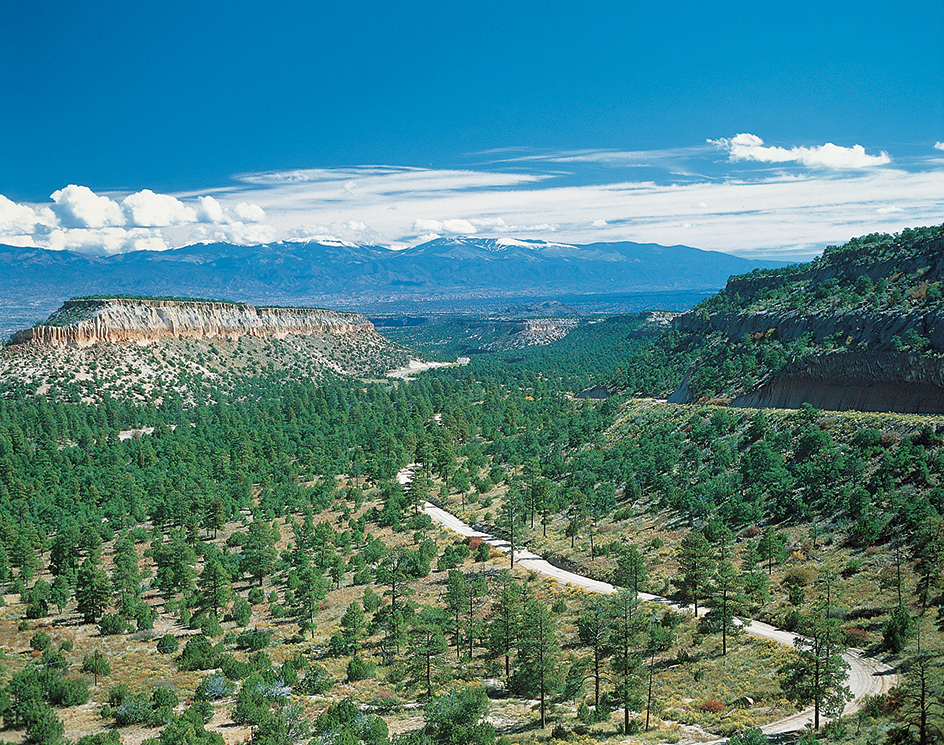
Indigenous American ceremonies, Spanish fiestas, and local rodeos are among the most interesting events for visitors. The dates of events may vary from year to year, and among the different tribes and pueblos. Numerous tribal ceremonies are held throughout the year.
Land and climate
Land regions.
New Mexico has four main land regions: (1) the Great Plains, (2) the Rocky Mountains, (3) the Basin and Range Region, and (4) the Colorado Plateau.
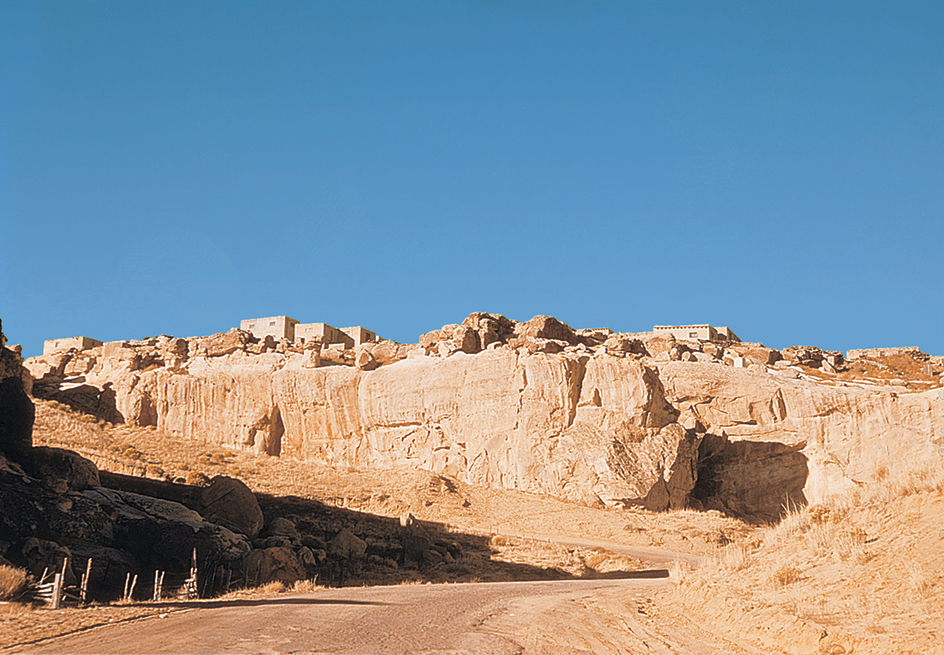

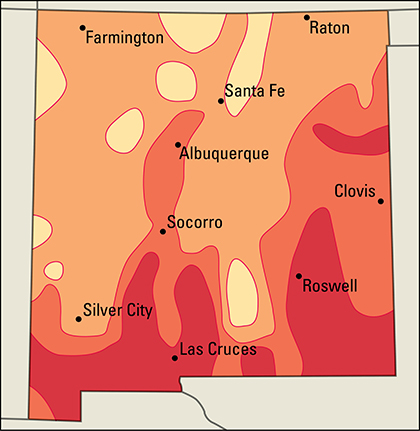
The Great Plains
of New Mexico are part of the vast Interior Plain that sweeps across North America from Canada to Mexico. In New Mexico, the Great Plains cover roughly the eastern third of the state. They extend from a high plateau in the north to the Pecos River Valley in the south. Streams have cut deep canyons in the plateau as it slopes away from the Rocky Mountains. Cattle and sheep graze there. To the south are dry farming and irrigated agriculture. The eastern edge of the state, south of the Canadian River, is called the High Plains or Llano Estacado (Staked Plain). The Llano Estacado also covers much of northwestern Texas (see Texas (Land regions)).
The Rocky Mountains
extend into north-central New Mexico from Colorado south to a point near Santa Fe. In winter, deep snow piles up on the mountains. In spring, the snow melts and provides water for irrigated crops in the fertile Rio Grande Valley. The Rio Grande, which rises in Colorado, cuts between ranges of mountains. To the east are the Sangre de Cristo (Blood of Christ) Mountains. Wheeler Peak, 13,161 feet (4,011 meters) high, is the highest point in the state. The Nacimiento and Jemez ranges are west of the river.
The Basin and Range Region
covers about a third of the state. It extends south and west from the Rockies to the borders with Arizona and Mexico. This region includes scattered ranges of rugged mountains—the Guadalupe, Mogollon, Organ, Sacramento, and San Andres ranges. Broad desert basins (low places where the streams have no outlet) lie between the mountains. The largest basins are the Jornada del Muerto (Journey of the Dead) and the Tularosa. The Rio Grande flows through the Basin and Range Region.
The Colorado Plateau,
in northwestern New Mexico, is a broken country of wide valleys and plains, deep canyons, sharp cliffs, and rugged, lonely, flat-topped hills called mesas. The best-known mesa in the state is Acoma. The Pueblo people built a city on top of Acoma. To the west of Acoma is a 40-mile (64-kilometer) strip of malpais, an area of extinct volcanoes and lava plains. Ship Rock, a steep hill that resembles a ship under full sail, has been a famous landmark in San Juan County for hundreds of years. Ship Rock rises 1,678 feet (511 meters) above the flat land around it. The San Juan Basin lies in the northwest section of the Colorado Plateau. The Continental Divide passes through both the Colorado Plateau and the Basin and Range Region. Streams west of the divide run into the Pacific Ocean. Water east of it runs to the Gulf of Mexico.
Rivers and lakes.
The Rio Grande runs like a backbone down the length of New Mexico. At the state’s southern boundary it turns east and forms the border between Texas and Mexico. A series of dams stores water for irrigation. Elephant Butte Dam, near Truth or Consequences, blocks the Rio Grande and forms Elephant Butte Reservoir, New Mexico’s largest lake. Its water irrigates land in New Mexico, Texas, and Mexico. Another important river is the Pecos. It rises in the Sangre de Cristo Mountains, and then flows south. The Pecos provides irrigation water for the land around Carlsbad and Roswell. The San Juan River drains the northwest corner of the state. The Canadian River rises in the northeast part. Its waters are stored for irrigation at the Conchas Dam, near Tucumcari. The Gila River, in the southwest, flows west into Arizona.
New Mexico has few natural lakes. Most famous are the deep Bottomless Lakes, a group of pools near Roswell. Artificially created lakes other than Elephant Butte Reservoir include Abiquiu, Avalon, Bluewater, Caballo, Cochiti, Conchas, Eagle Nest, El Vado, Heron, McMillan, Navajo, Sumner, and Ute.
Plant and animal life.
Forests cover about a fourth of New Mexico. Common trees include aspens, cottonwoods, Douglas-firs, junipers, piñons (nut pines), ponderosa pines, scrub oaks, spruces, and white firs. The yucca, New Mexico’s state flower, grows in most areas. Desert plants include cactus, creosote bush, grama grass, mesquite, white and purple sage, and soapweed. Cattle ranchers guard their livestock from the poisonous locoweed. Wild mountain plants include forget-me-nots, saxifrages, sedges, alpine larkspur, and other flowers.
Animal life is plentiful in New Mexico. Among the larger animals are black bears, coyotes, mountain lions, pronghorns, deer, and elk. Other animals include badgers, beavers, bobcats, chipmunks, foxes, jack rabbits, minks, otters, and prairie dogs.
Among the state’s game birds are ducks, grouse, pheasants, quail, and wild turkeys. Many varieties of geese and sandhill cranes migrate to New Mexico for the winter. Common fishes include black bass, catfish, crappies, perch, suckers, and trout. Two kinds of poisonous snakes, the rattlesnake and the coral snake, live in New Mexico. The southwestern desert is the home of many spiders, including various kinds of tarantulas and the western black widow.
Climate.
New Mexico has a dry, warm climate. A person may hang out clothes in the rain knowing the rain will stop soon, and the air will dry the clothes quickly. The state averages less than 20 inches (51 centimeters) of precipitation (rain, melted snow, and other forms of moisture) a year. It varies from over 20 inches in the northern mountains to less than 12 inches (30 centimeters) in the south and central areas. Snow falls throughout the state. The south receives only about 2 inches (5 centimeters) a year. The high mountains may get as much as 300 inches (760 centimeters) of snow each year. 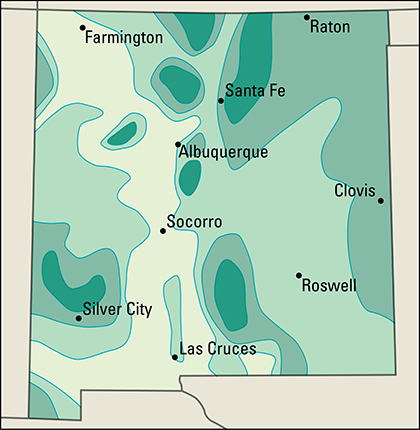
The average July temperature is about 76 °F (24 °C). January temperatures are generally warmer in the south than in the north. The state’s average January temperature is 36 °F (2 °C). Day and night temperatures vary widely on the same day. The thin, dry air does not stay warm after sundown because of the high altitude. The lowest recorded temperature was –50 °F (–46 °C) at Gavilan, near Lindrith, on Feb. 1, 1951. The highest temperature was 122 °F (50 °C) near Carlsbad on June 27, 1994.
Economy
Although New Mexico has limited water resources and large tracts of desert, the state’s natural resources continue to play a major role in its economy. Tourism, mining, and agriculture provide valuable jobs for the state’s workers.
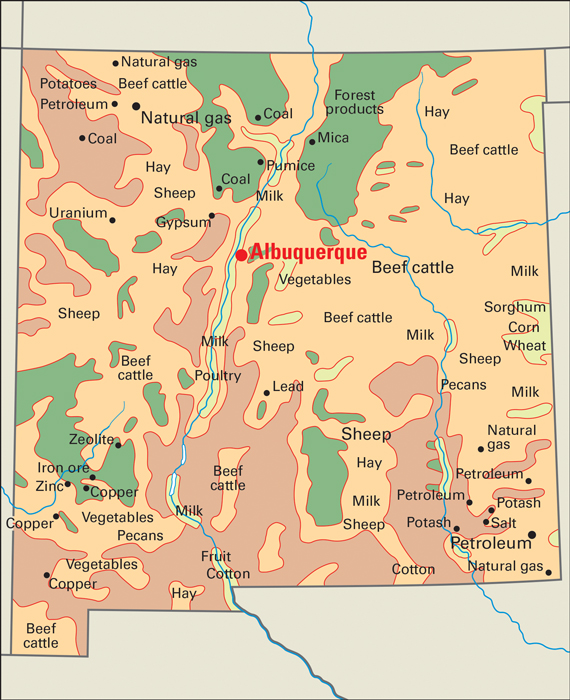
The state’s scenic beauty and reputation as an arts and cultural center attract tourists all year. The state’s handcrafted pottery and jewelry are world famous. Tourists flock to New Mexico’s many ski resorts in the winter. Large crude oil and natural gas reserves make New Mexico an important mining state. Cattle ranching and dairy farming provide the most farm income.
Large federal government research laboratories are among New Mexico’s leading employers. Electronic products are a major type of manufacture.
Natural resources
include large mineral deposits and rich, renewable resources based on the soil. These resources include forests, grasses, plants, and animals.
Minerals.
New Mexico is rich in mined products that supply energy. It has large reserves of coal, crude oil, natural gas, and uranium. The state is the nation’s leading producer of potash, a vital fertilizer material, and of perlite, a lightweight rock used in insulation and in potting mix. New Mexico has one of the largest copper reserves in the nation. Large reserves of carbon dioxide gas are found in a deposit called the Bravo Dome in the northeast part of the state. The state also ranks high in the production of pumice and zeolites.
Soil.
More than half of New Mexico’s soil is stony and shallow, and not good for farming. Most of the crop and dairy farming occurs in the eastern part of the state, which has sandy soil. Important agricultural soils also occur along the Rio Grande valley.
Water
is precious in New Mexico, and water resources are extremely important. New Mexico and other Western states have joined with Mexico to share the use of water in various streams. Each area gets a share. For example, Colorado users must allow a certain amount of Rio Grande water to flow into New Mexico. New Mexico’s resources include underground water.
New Mexico has a number of major storage projects that help make good use of water. These projects regulate the flow of the Canadian, Pecos, Rio Grande, and San Juan rivers, and some of their tributaries.
Forests
cover about one-fifth of the state. There are commercially valuable timberlands in several mountain areas. The most common trees include the aspen, cottonwood, Douglas-fir, juniper, piñon, ponderosa pine, scrub oak, spruce, and white fir.
Service industries
provide the greatest part of both New Mexico’s employment and its gross domestic product—the total value of all goods and services produced in the state in a year. Many of the service industries are concentrated in the Albuquerque-Santa Fe area. 
Government activities are important to New Mexico’s economy. Santa Fe, the state capital, is the center of state government activities. Federal government research laboratories and military bases also play a major role in the state’s economy. Los Alamos National Laboratory is a world leader in research of military and nonmilitary uses of nuclear energy. Sandia National Laboratories in Albuquerque is a center of nuclear weapons research. Military bases in New Mexico include Cannon Air Force Base in Clovis, Holloman Air Force Base near Alamogordo, Kirtland Air Force Base near Albuquerque, and White Sands Missile Range in the south-central part of the state. The Bureau of Indian Affairs, a federal government agency, assists the state’s Indigenous population. Jobs at casinos on New Mexico’s Indian reservations contribute to local government employment in the state.
Albuquerque is the chief banking and insurance center. Many hotels, restaurants, and retail trade establishments are in the Albuquerque and Santa Fe areas. New Mexico’s restaurants, hotels, and ski resorts greatly benefit from the billions of dollars tourists spend in the state each year. Real estate is also important to New Mexico’s economy. New Mexico’s population growth has led to the development of many new homes and office buildings.
Manufacturing.
Computer and electronic equipment is a leading manufactured product category. Intel, a major electronics company in the Albuquerque area, produces silicon chips for computers. 
Other products manufactured in New Mexico include aircraft and aircraft parts, chemicals, concrete, food products, and petroleum products. Large oil refineries operate near Artesia and Gallup. The Albuquerque area is the state’s chief manufacturing center.
Mining.
New Mexico is a leading state in the annual value of mined products. Natural gas and petroleum together account about 85 percent of the state’s total income from mined products. Both natural gas and petroleum are produced in northwestern and southeastern New Mexico. Coal, found mainly in surface mines in the northwest, is also a significant source of New Mexico mining income. Carbon dioxide from Harding, Quay, and Union counties is used to help extract oil from fields in the Permian Basin of Texas and southeast New Mexico.
Copper and potash account for most of New Mexico’s income from nonfuel mined products, and New Mexico is a leading producer of both minerals. Copper is mined primarily in Grant County. Potash, an ingredient in many fertilizers, comes mainly from deep underground mines in southeastern New Mexico. Gold and silver are also mined.
Agriculture.
Farmland covers about half of the state’s land area. Cattle ranching is the leading agricultural activity in New Mexico. Ranchers raise beef cattle in almost every part of the state. Most of the beef cattle are shipped to other states for fattening and slaughtering. Dairy cattle are raised mainly in southern and eastern New Mexico. The state’s other livestock products include chicken eggs and turkeys.
Most of New Mexico’s cropland is irrigated. One leading crop is hay, used to feed cattle. New Mexico is a leading producer of chili peppers and pecans. Other crops include corn, cotton, onions, potatoes, and wheat.
Electric power and utilities.
Power plants that burn coal or natural gas supply the majority of the electric power generated in New Mexico. Electric power produced by wind, solar, water, and geothermal sources is of increasing importance in the state.
Transportation.
New Mexico has an extensive system of roads and highways. The first road established by Europeans in what is now the United States—El Camino Real (the Royal Highway)—ran from Santa Fe to Mexico City, Mexico. Spaniards first traveled this route in about 1581. The Santa Fe Trail was opened in 1821 between Missouri and New Mexico. Today, Interstate 25 east of Santa Fe follows this old trail. Albuquerque International Sunport is the chief airport in New Mexico. 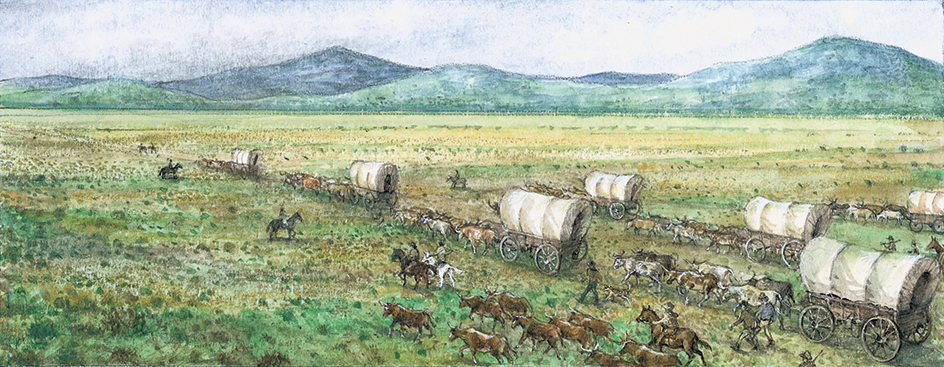
Communication.
The first Spanish-language newspaper in New Mexico, El Crepúsculo de la Libertad (The Dawn of Liberty), began in 1834 at Santa Fe. The Santa Fe Republican, the first English-language paper, was founded in 1847. Today, the state’s most widely read newspapers include the Albuquerque Journal, the Las Cruces Sun-News, and The Santa Fe New Mexican.
Government
Constitution.
New Mexico is governed under its original state constitution. The Constitution was adopted in 1911, a year before New Mexico became a state.

Amendments may be proposed by either house of the state Legislature. They must be approved by a majority of the voters in a regular or special election. Some sections of the Constitution require special majority votes to be amended. These sections guarantee the voting rights and education of Spanish-speaking people. Amendments to these sections must be approved by three-fourths of the voters in the state. A constitutional convention may be called by a two-thirds vote of the Legislature, if a majority of the voters approve. The voters must approve amendments proposed by a constitutional convention.
Executive.
New Mexico’s governor serves a four-year term. Other executive officers elected to four-year terms are the lieutenant governor, secretary of state, auditor, treasurer, attorney general, and commissioner of public lands. Executive officers may hold office for any number of terms, but not for more than two terms in a row.
Much of the governor’s authority lies in the power of appointment. For example, the governor appoints four of the seven members of the State Board of Finance and is a member of the board as well. The governor also appoints most of the directors or board members who run state agencies and institutions. The governor may veto legislation passed by the state Legislature.
Legislature
of New Mexico consists of a 42-member Senate and a 70-member House of Representatives. There are 42 senatorial districts and 70 representative districts. Voters in each senatorial district elect one senator. Voters in each representative district elect one representative. Senators serve four-year terms. Members of the House of Representatives serve two-year terms. 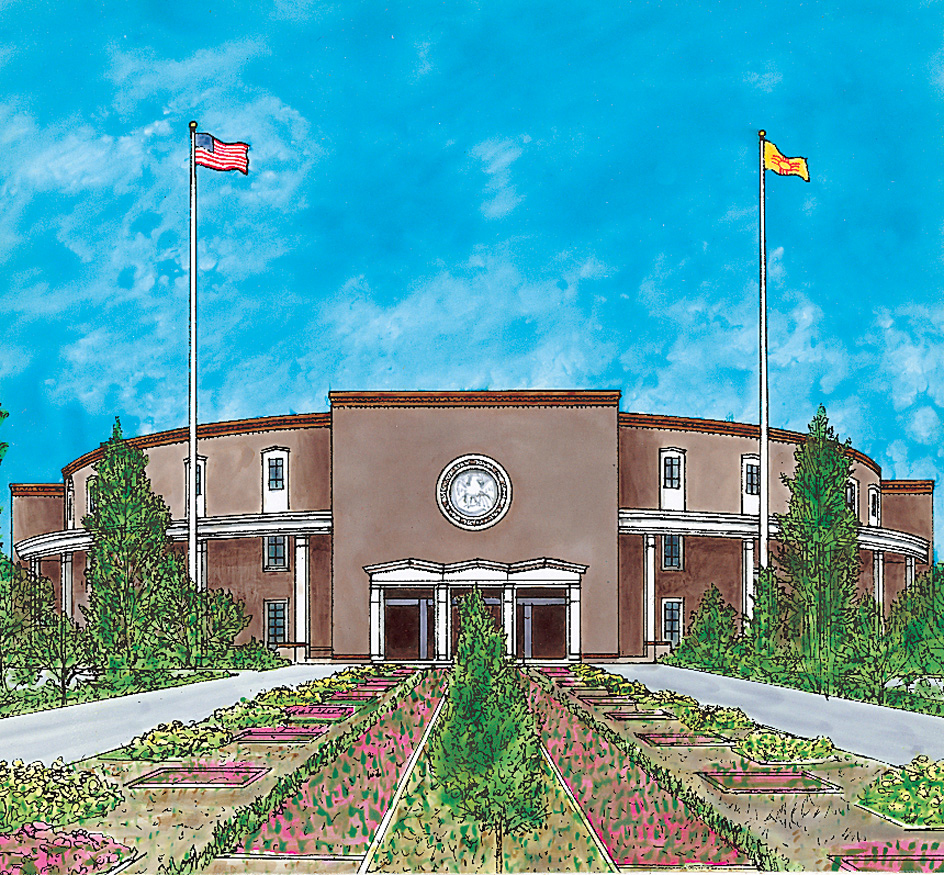
The Legislature meets every year on the third Tuesday in January. The sessions are limited to 60 days in odd-numbered years, and to 30 days in even-numbered years. The governor or the Legislature itself may call a special session. The Constitution provides for the power of referendum, in which a proposed law is submitted to the voters for their approval, but not for initiative, in which voters may propose a law.
Courts.
The state Supreme Court is the highest court. It has five justices elected to eight-year terms. Terms are staggered so an entirely new court is not elected in any one election. Every two years, the justices select a member of the court to be chief justice.
The Court of Appeals has 10 judges, who are elected to eight-year staggered terms. Panels made up of three judges hear appellate cases. Most cases that this court hears may be taken to the Supreme Court.
District courts are the state’s principal trial courts. New Mexico has district judges elected from 13 judicial districts. They hold district court sessions in each of the state’s 33 counties. District judges are elected for terms of six years. They also serve as juvenile judges if the defendant is under 18 years old. Other New Mexico courts include magistrate, municipal, and probate courts.
Local government.
New Mexico has 33 counties. A city-county council administers Los Alamos County. The other counties are run by a board of commissioners. All commissioners are elected to four-year terms. They may serve two terms in a row but must then wait two years before they can be elected again to any county office.
State law gives municipalities (towns, villages, or cities) a wide choice of form of government. Most common are the mayor-council, commission, and city manager-commission forms. Cities can adopt their own charters. Alamogordo, Albuquerque, Clovis, Gallup, Grants, Hobbs, Las Cruces, Las Vegas, Los Alamos, Rio Rancho, Santa Fe, and Silver City have their own. Municipal elections occur every two years.
Revenue.
Taxes account for about 35 percent of the state government’s general revenue (income). Federal grants and other United States government programs and charges for state government services make up most of the rest. A general sales tax provides the greatest portion of New Mexico’s tax revenue. Other sources of tax revenue include taxes on corporate and personal income, mining, and motor fuels.
Politics.
In voter registration, Democrats usually outnumber Republicans. Democrats generally enjoy support in the state’s larger cities, among newcomers to the state, and among Hispanic Americans. In the north-central counties, the Spanish American population has been largely Democratic since the early 1930’s. The center of Republican strength lies in the southeast portion of the state. Voters there tend to be conservative and vote much like the residents of west Texas.
History
Early days.
Indigenous Americans have lived in what is now New Mexico for thousands of years. Stone spearheads found at Folsom and other places indicate that Indigenous peoples hunted in northeastern New Mexico at least 10,000 years ago. The spearheads are known as Folsom points. See Folsom point.
From about 500 B.C. to A.D. 1200, the Mogollon people lived in the valleys located in the area of the New Mexico-Arizona border. At first the Mogollon lived in houses dug partly into the ground. Later, they built villages that stood above the ground. See Mogollon.
Another group of ancient people lived in the region where New Mexico, Arizona, Utah, and Colorado meet. They were the Ancestral Pueblo, once called the Anasazi, who had one of the most highly developed civilizations in North America. The Ancestral Pueblo raised corn and cotton, and tamed wild turkeys. The big birds provided food and clothing. In winter, the people wore robes made of turkey feathers and rabbit fur. Some Ancestral Pueblo were cliff dwellers and built many-storied apartment houses of closely fitted stones. Many other Ancestral Pueblo built apartment houses on flat surfaces. One such building, the Pueblo Bonito (pretty village), probably had about 600 or 700 rooms. Sometimes the Ancestral Pueblo built towns on top of steep mesas. Today’s Pueblo people are the descendants of these people. See Ancestral Pueblo. 
The Navajo and Apache tribes came from the north about A.D. 1500. The Ute and Comanche came a few years later.
Exploration, conquest, and settlement.
The first Spanish explorers reached the New Mexico area almost by accident. Álvar Núñez Cabeza de Vaca was a member of a group seeking gold in Florida in 1528. He and others became separated from the expedition’s ships. In an attempt to reach New Spain (now Mexico), they sailed on barges to the Texas coast. In 1536, after wandering for eight years, Cabeza de Vaca and three companions—two Europeans and an African—reached a settlement near the Pacific coast of New Spain. They told stories of seven cities of great wealth, called the Seven Cities of Cíbola, to the north. See Cíbola, Seven Cities of.
The Spaniards were determined to find the seven rich cities. Guided by Cabeza de Vaca’s African companion, Estevanico, also called Estéban, a priest named Marcos de Niza made a search in 1539. He claimed the area as a province of Spain. Marcos de Niza also reported that he had seen one of the cities from a distance.
Francisco Vásquez de Coronado, also in search of the seven cities, explored present-day New Mexico and Arizona from 1540 to 1542. But he found only the pueblos of Indigenous people. Fray Augustín Rodríguez and Captain Francisco Sánchez Chamuscado traveled up the Rio Grande from New Spain in 1581. The report of a later explorer, Antonio de Espejo, led to colonization of the region.
The first Spanish colony in New Mexico was established in 1598 at the Pueblo of Ohkay Owingeh, which the Spanish called San Juan de los Caballeros, near the Chama River. The colony was financed and established by Juan de Oñate. He became governor of the province of New Mexico. Oñate was succeeded as governor by Pedro de Peralta, who moved the capital to Santa Fe in 1609 or 1610. Santa Fe is the oldest seat of government in the United States. 
The colony had little wealth and grew very slowly. It was kept alive mainly by the efforts of missionaries. Roman Catholic priests from Spain established schools to teach Christianity to Indigenous people. But repeated quarrels occurred between the church and civil authorities, and between the Spaniards and Indigenous people.
The Spaniards set up a system of forced labor for the Pueblo people that was much like slavery. The Spaniards also charged the people an annual tax of corn and blankets. In addition, they kept the Pueblo from worshiping their ancient gods. Popé, a leader from the San Juan Pueblo, led a revolt in 1680. The Pueblo people killed more than 400 Spaniards and drove the rest to the region near what is now El Paso, Texas. The Pueblo rebellion destroyed almost every trace of the Roman Catholic Church. Historians have called the 1680 Pueblo revolt the most successful act of resistance by an Indigenous group against a European colonizer in North America.
In 1692, the Spanish governor Diego de Vargas took back the province. Four years of scattered fighting broke the power of the Pueblo. The colonists and priests returned to build homes and missions in and near Santa Fe. For 125 years, the Spaniards and Pueblo people lived together in this lonely outpost of the Spanish Empire.
Mexican rule.
During the early 1800’s, trappers and traders came from the United States to the region that would later become New Mexico. Spanish officials feared the newcomers and expelled them or put them in prison. But the Spanish officials were replaced in 1821, after Mexico won its freedom from Spain. New Mexico became a province of Mexico. That same year, William Becknell, an American trader, opened the Santa Fe Trail to bring goods to New Mexico from Missouri.
Mexico ruled the area for the next 25 years, a period filled with unrest. In 1837, Mexicans and Indigenous groups in New Mexico rebelled against the Mexican government. They executed the governor and seized the Palace of Governors in Santa Fe. A Taos leader, José Gonzales, was installed as their chief executive. But a month later, Mexico’s General Manuel Armijo crushed the rebellion and became governor.
In 1841, an expedition from Texas (then an independent country) invaded New Mexico. The Texans claimed the land east of the Rio Grande. However, Mexican troops defeated the invaders and sent them as captives to Mexico City. They were later freed.
The Mexican War.
As colonists from the United States pushed west, trouble developed between the United States and Mexico. In 1846, war broke out, and U.S. forces under General Stephen W. Kearny took control of New Mexico with little resistance. The Treaty of Guadalupe Hidalgo ended the war in 1848, and the U.S. took possession of the region. See Mexican War.
Territorial days.
In 1850, Congress organized New Mexico as a territory. The territory also included what is now Arizona and parts of present-day Colorado and Nevada. In 1853, the Gadsden Purchase enlarged the territory (see Gadsden Purchase). Mexico sold the United States land south of the Gila River, between the Rio Grande and the Colorado River. New Mexico got its present boundaries in 1863, after Congress organized the territories of Colorado and Arizona.
Early in the Civil War (1861-1865), Confederate forces from Texas captured much of the region, including Albuquerque and Santa Fe. Union forces recaptured the territory in March 1862, after two battles southeast of Santa Fe. The first clash was fought in Apache Canyon, and the second in Glorieta Pass. Between 1862 and 1864, Colonel Kit Carson, a famous frontier scout, led the New Mexicans in forcing both the Mescalero Apache and the Navajo tribes to live on a reservation.

During the late 1870’s, cattlemen and other groups fought for political control of Lincoln County. The bitterness burst into open violence with the murder of rancher John G. Tunstall. Billy the Kid and other outlaws took a leading part in the fighting, which became known as the Lincoln County War. General Lew Wallace was appointed territorial governor in 1878. He pardoned the fighters to end the bloodshed. Pat Garrett, the sheriff of Lincoln County, killed Billy the Kid in 1881. Sheriffs, including Garrett, and territorial governors helped establish order during the 1880’s.
The Apache Chief Victorio led frequent attacks on settlers from 1879 until his death in 1880. Geronimo, an Apache warrior, continued to fight U.S. troops and settlers in the area until he surrendered on Sept. 4, 1886. During the late 1800’s, after railroads linked the territory to the rest of the nation, New Mexico experienced a cattle and mining boom.
Early statehood.
New Mexico became the 47th state on Jan. 6, 1912. It had a population of about 330,000. The people elected William C. McDonald as the first state governor. 
Mexican rebels, probably led by Pancho Villa, raided the town of Columbus in 1916, killing 16 Americans. The U.S. Army sent an expedition into Mexico to catch Villa, but it failed. During World War I (1914-1918), New Mexico sent over 17,000 men into the armed forces.
In the early 1920’s, a long drought made life difficult for farmers and ranchers. Livestock prices dropped, and the stock owner’s financial troubles spread. Banks closed, and many people lost their savings. But new businesses developed. Oil was discovered in the 1920’s, and huge potash deposits at Carlsbad were opened. In 1930, the famous caverns near Carlsbad became a national park, and the tourist industry grew. 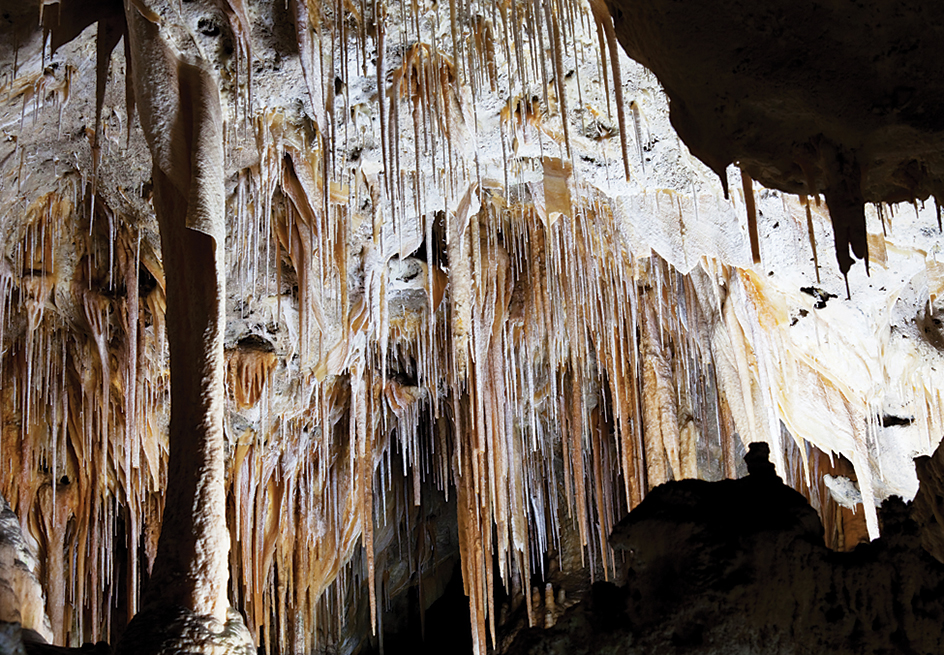
World War II.
When the United States entered World War II in 1941, the 200th Coast Artillery, composed of New Mexico soldiers, was in the Philippine Islands. The Japanese overwhelmed the regiment, along with the rest of the U.S. forces on Bataan Peninsula. Many of the soldiers were killed, and others spent over three years in Japanese prison camps. The war ended after U.S. planes dropped two atomic bombs on Japan in August 1945. The bombs had been produced at Los Alamos, a town and laboratory built secretly in the New Mexico mountains. The world’s first atomic bomb was exploded at Trinity Site, near Alamogordo, on July 16, 1945.
The mid-1900’s.
After World War II ended in 1945, the government continued to spend large amounts of money in New Mexico for research. The state’s economy and population both grew rapidly as the government provided funds for work on nuclear power development and experiments with rockets. The economy also was aided by the discovery of uranium in northwestern New Mexico in 1950.
The state’s coal industry grew in the mid-1960’s. A large coal mine was opened near Raton, and coal-burning electric generating plants were built near Farmington. But production of potash decreased in the Carlsbad area because of competition from Canadian potash mines.
During the 1960’s, construction and improvement of winter sports resorts helped to increase tourism. Income from tourists almost doubled in the state.
Lack of water has always created problems in New Mexico. Some of these problems were solved with completion of the San Juan-Chama project in the 1970’s. This project brings water to north-central New Mexico through tunnels from branches of the San Juan River in the Rocky Mountain area. Reservoirs built near Chama and Abiquiu as part of the project provide recreational facilities and water for irrigation.
Recent developments.
Today, New Mexico ranks as a leading center for space and nuclear research. A leading private employer in the state is Sandia National Laboratories of Albuquerque, which conducts research and does engineering work on the uses of nuclear energy. At Los Alamos, government scientists work on many projects involving military and nonmilitary uses of nuclear energy. Military bases and manufacturing for military projects also contribute to the economy. Substantial reductions in military spending took place in the early 1990’s after the Cold War ended. But the growth of nongovernment industries helped compensate for the military reductions. Manufacturing and construction industries in New Mexico experienced growth in the 1990’s. In 1998, New Mexico celebrated the 400th anniversary of the founding of the colony at San Juan.
Tourism continued to play a strong role in the state’s economy into the 2000’s. Some academics and leaders of native groups, however, have charged that the state has promoted “cultural tourism” while neglecting the deep-seated poverty that remains in many native communities. In 2009, New Mexico abolished the death penalty. Also in 2009, construction began on Spaceport America, a project intended to aid in the commercial development of space. The publicly funded project, at Upham in southern New Mexico, has launch facilities for both rockets and spaceplanes. In 2010, New Mexico voters elected Susana Martinez governor. Martinez took office in 2011 and served through 2019. She was the first woman to serve as governor of the state and the first Hispanic woman governor in the United States. 
Severe wildfires and historic drought posed threats to New Mexico residents and wildlife in the early decades of the 2000’s. In 2011, the Las Conchas Fire burned more than 150,000 acres (60,000 hectares) near Los Alamos. In 2012, the Whitewater-Baldy Fire burned about 300,000 acres (121,000 hectares) in the Gila National Forest in the western part of the state. High temperatures, drought, and strong winds fueled a number of wildfires in 2022. Fires that burned areas east of Santa Fe became the largest in the state’s history.
